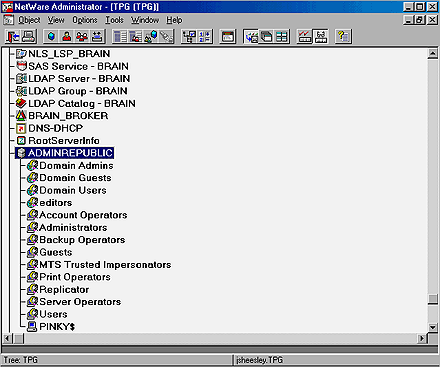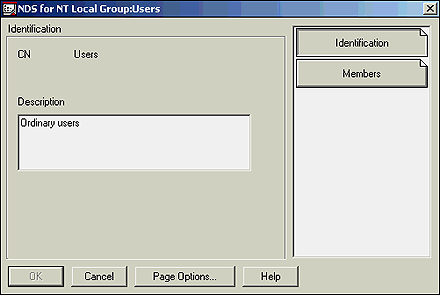Other NDS for NT objects
If you double-click the Domain object, you'll see additional objects within the
domain, as shown in Figure F. If you've administered Windows NT before,
you'll immediately recognize the icons as being Windows NT group and workstation
objects. Domain objects can contain Alias objects, NDS for NT Global Group
objects, NDS for NT Local Group objects, and NDS for NT Workstation objects.

Figure F The Domain object contains other NDS for NT objects.
Alias objects within a Domain object are just like regular Alias objects. All
they do is reference other objects in the NDS tree. Unlike standard NDS Alias
objects, NDS for NT Alias objects can reside only within a Domain container.
Additionally, NDS for NT Alias objects can alias only other NDS for NT objects.
The NDS for NT Global Group object represents global groups that reside in the
NT server's domain. Global groups contain User objects that have common rights
on the NT server. If you have multiple domains on your network, you can also use
global groups in conjunction with trust relationships to grant rights across
domains.
The NDS for NT Local Group object represents local groups that reside in the NT
server's domain. As the name suggests, local groups represent groups that reside
and control rights only within the NT server's domain. No matter how you've
configured trust relationships, local groups aren't accessible outside the
domain. Unlike global groups, local groups can contain global groups as well as
User objects.
If you right-click the NDS for NT Local Group object (or the NDS for NT Global
Group object) and select Details, you'll bring up the properties notebook for
that object type. The properties notebooks for both object types are very
similar and have only two tabs—Identification and Members. Figure G
shows the properties notebook for the NT Local Group object.

Figure G The NDS for NT Local Group object and NDS for NT Global Group
object have similar properties.
The Identification tab displays a description of the object. You can include
additional information in the Description field. If you click the Members tab,
you can see which users belong to the group. You can add users by clicking Add
and selecting the user or users from the list of available objects. To delete a
user, highlight it and click Delete.
The NDS for NT object that a Domain object can contain is the NDS for NT
Workstation object. The NDS for NT Workstation object represents workstations
and servers that reside in the NT server's domain. Don't confuse this object
with the regular NDS Workstation object. If you right-click the NDS for NT
Workstation object and select Details, you'll see that this object is for
information purposes only. You can enter a name and description, but that's it.



